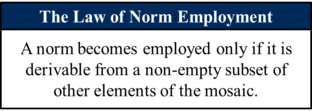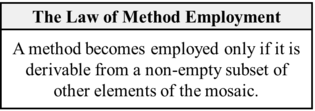Modification:Sciento-2022-0002
Accept the new law of norm employment that fixes some of the issues of the current law of method employment and makes it applicable to norms of all types.
The modification was suggested to Scientonomy community by William Rawleigh on 28 February 2022.1 The modification is currently being evaluated; a verdict is pending.
Contents
Preamble
At present, there are several problems with how the third law is formulated and operates that need to be resolved. Foremost among these is that the third law is, in its current form, based on an outdated ontology that assumes that methods of theory evaluation are a fundamental member of our ontology of epistemic elements. After the acceptance of Barseghyan’s proposal that methods be subsumed under the category of normative theories, the third law no longer exhaustively covers any situation in which we employ any kind of normative theory. In its present form it is limited to methods, though there is no strictly logical justification at present for thinking that the mechanism by which a method is employed is any different than the mechanism by which any other norm is employed.
In addition, the current formulation of the third law uses the term deducible, which currently lacks a scientonomic definition. We do not currently know what it means for something to be deducible, what the criteria of deducibility would be, or whether the conditions of deducibility would be part of the first-order theories of the mosaic or part of the second-order theories that range over the mosaic.
The third issue with the current formulation is that, with the acceptance of questions into the epistemic elements of the ontology of scientific change, the elements of the mosaic are now more expansive than just theories and subtypes of theories. This means that there is a plausible situation in which norms could potentially be derived – at least in part – from questions, which means that a formulation of the third law that excludes questions would fail to comprehensively describe all cases of norm employment.
The new law of norm employment aims to remedy all three of these issues:
- the formulation of the covers all norms rather than only methods;
- it replaces deducible with derivable, which in the context of mathematical model theory simply means to be semantically entailed, and thus can potentially include non-deductive inferences (e.g. inductive, abductive);
- it replaces a specific enumeration of epistemic elements with a general "elements of the mosaic".
This definition also offers the slight clarification that derivability strictly deals with derivation from a finite number of other elements.
A law of method employment can be deduced strictly from the law of norm employment.
Modification
Theories To Accept
- The Law of Norm Employment (Rawleigh-2022): A norm becomes employed only if it is derivable from a non-empty subset of other elements of the mosaic.
- The Law of Method Employment (Rawleigh-2022): A method becomes employed only if it is derivable from a non-empty subset of other elements of the mosaic.
Theories To Reject
- The Third Law (Sebastien-2016): A method becomes employed only when it is deducible from some subset of other employed methods and accepted theories of the time.
Questions Answered
This modification attempts to answer the following question(s):
- Mechanism of Method Employment: How do methods become employed by an epistemic agent?
- Mechanism of Norm Employment: How do norms become employed by an epistemic agent?
Verdict
The modification is currently being evaluated; a verdict is pending.
Click on the Discussion tab for comments.
References
- ^ Rawleigh, William. (2022) Reconceiving Scientific Mosaics: A New Formalization for Theoretical Scientonomy. In Barseghyan et al. (Eds.) (2022), 83-103.

